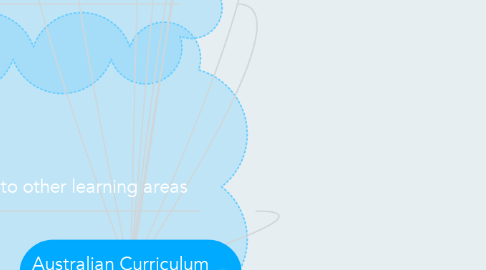Australian Curriculum Technologies
by lynn humby


1. General Capabilities
1.1. Literacy
1.1.1. Numeracy
1.1.1.1. ICT
1.2. Critical and creative thinking
1.2.1. Personal and social capabilities
1.2.2. Ethical understanding
1.2.3. Intercultural understanding
2. Links to other learning areas
2.1. English
2.2. Mathematics
2.3. Science
2.4. History
2.5. Geography
2.6. The Arts
2.7. Health and Physical Education
2.8. Economics and Business
3. Student Diversity
3.1. Technology encompasses students with disabilities, gifted and talented students and students with English as a second language
4. Band Levels
4.1. F-2, 3-4, 5-6,7-8.9-10
5. Cross Curricular Priorities
5.1. Asia and Australia's engagement with Asia
5.2. Aboriginal and Torres Strait Islanders Histories and Cutures
5.3. Sustainability
6. Aims and objectives
6.1. Content elaborations and descriptors provide extensive detail as to what is required in each year group
7. Achievement Standards cover the expected levels students are expected to achieve in each particular band.
8. Key concepts and ideas
8.1. Creating preferred futures
8.2. Project management
8.3. Thinking in technologies
8.3.1. Systems thinking
8.3.1.1. Design thinking
8.3.1.1.1. Computational thinking
8.4. Information and communication technology in AC
8.5. Safety
8.6. Animal ethics
9. SCASA has been adapted from the Australian Curriculum and is specific to Western Australia
9.1. ACARA
9.2. SCASA
10. Subjects
10.1. Design and Technologies
10.2. Design and Technologies
10.2.1. Strands
10.2.1.1. Knowledge and Understanding
10.2.1.1.1. Technology and Society
10.2.1.1.2. Technology contexts
10.2.1.2. Processes and Production Skills
10.2.1.2.1. Creating solutions by
10.3. Digital Technologies
10.3.1. Strands
10.3.1.1. Processes and Production Skills
10.3.1.1.1. Task 2 Daisy the Dinosaur
10.3.1.1.2. Task 2 Bits and Bricks
10.3.1.2. Knowledge and Understanding
10.3.1.2.1. Digital systems
10.3.1.2.2. Representation of data
